Wednesday, October 26, 2005
What if....
In "What if" there's a strong element of wanting change, longing for a world where every child can wake up surrounded by family and friends, with enough food and material goods, without terror and war. Where every single person finds someone to love, and where the word "loneliness" is out of the vocabulary. Maybe childish dreams, but what if another world is possible?
WHAT IF IT'S UP TO US?
WHAT IF IT'S UP TO ME?
Friday, October 14, 2005
A friendly face
In my life I have experienced several times how a human face and its expressions can change my day. When I was younger I spent a lot of time in one of the churches of Oslo. Sometimes I participated in the service in doing worship, at communion or in leading the service. When I was looking at a big group of people knowing that they looked at me, I was amazed to see how “closed” a lot of their faces were, but there – in the middle of the church was a smiling, open face of an older woman with white hair. I will never forget her face – showing with every part of her face that she appreciated me taking part and showing me that she wanted me to do my best. More than ten years later I still feel the positive energy of her smiling eyes and her positive attitude.
Another experience was three years ago. For months I’d been taking part in the preparation of a conference for Church of Norway. For the conference we invited, as the main speaker, the founder of the movement L’Arche, Jean Vanier. I’d read some of his work, and listened to a couple of his sermons and was a little nervous when I knocked at the door of his room at the conference center. He was sitting at the couch, and when I came into the room I looked into a face that broke into a wonderful, open smile. I had never met him before, but it felt like meeting a father that hadn’t seen his son for years. He rose up from the coach with a big smile and shook my hand while giving me 100 % of his attention.
In 1993 one of the greatest leaders the world has ever seen, Nelson Mandela, participated in a service in Oslo Cathedral. He was in Oslo as a laureate of the Nobel Peace Prize, and I was there to experience this legendary man. After the service Nelson Mandela walked down the aisle, and for just a couple of seconds his eyes met mine and I looked into this smiling, open face where every part of it tells a story of how love conquers hate, and how forgiveness suppress evil.
My inner image of these three faces will forever be with me and I wonder why. I guess we all long for the feeling of being seen, accepted and embraced. Our faces are our main communicative tools, and through it we can “read” the acceptance or rejection of others. In a world of words our faces “gives us away”. We can try to conceal what we feel, and often we do, but what if we dare to do like the woman in church, like Jean Vanier and Nelson Mandela. To let our faces and our bodies be the frame from where our souls might shine? I don’t know how these people are able to meet thousands and to be able to see them all, but I suspect it has something to do with a sense of being seen. By focusing on something outside of themselves, because they know that they are loved and that their contribution makes a difference in the life of their fellow man, to dare to think and know that every person, every creature is created and loved, worthy to be met through our faces, with openness and honesty. Wow, I’ve got such a long way to go, but I would have loved to be able to grasp only a little of what these three people have understood and made a part of their interaction with others.
Friday, October 07, 2005
The Man from Canterbury
 The Archbishop of Canterbury, Dr. Rowan Williams at the University of Oslo, October 7, 2005 (Photo: Norwegianblogger)
The Archbishop of Canterbury, Dr. Rowan Williams at the University of Oslo, October 7, 2005 (Photo: Norwegianblogger)During the last weeks I've been a part of a group that has been preparing the visit of The Archbishop of Canterbury, Dr. Rowan Williams in Norway. I like that kind of work, and when I've been working on a project for awhile it makes me curious about the person. Today I was able to take part in one of the many parts of his program here in Norway, namely his lecture at the University of Oslo. Afterwards I was able to exchange a few words with him and have a couple of photos of course, before he went on with his program. At his lecture he talked about "Christian thought and the Threat to Earth". The scarcity of resources represents a moral question. When people fight for resources, injustice happens. Every person has a fundamental right to have his or her vital needs met. The Church must answer these questions through actions, but also by finding theological answers. The Archbishop elaborated four different approaches. The first approach is relational / creational. The material world was brought into existence by a word from God. The LOGOS (the word) is basic for all encounters. LOGOS is God, and everything is brought into relationship with God by being created. Secondly is the contemplative approach with its emphasis on poverty. It's possible to think of poverty as a cleared vision of the world. When we free ourselves from all our attachments, we are able to get a clearer vision. In that way, poverty is a challenge to all addictive behavior. Thirdly there is the sacramental approach, that all things are related before it relates to us or me. Fourth he talked about the approach of justice. As is said in the book of Leviticus, we don't own the land, it is only lend to us. Our possessions are not ours, but are only there to be used for awhile. Care for the environment is decisive for the future of this planet. Access to clean water and unpolluted food is important for all of us, and shouldn't be of access to only a few. The challenge for us is to understand that even though one person can't change the world, every person can change one thing.
I felt privileged to be able to listen to this leader of the world's 77 million Anglicans in 160 countries. I didn’t understand everything. I’m not a theologian, and I guess my British English understanding is a little corrupted after staying a year in the US, but Dr. Williams seems to care for the world, and has found a way to make theology into action. We need that, and we need leaders that show us the challenges for the church and the world today.
 Archbishop of Canterbury, Dr. Rowan Williams in Oslo, October 7, 2005 (Photo: Norwegianblogger)
Archbishop of Canterbury, Dr. Rowan Williams in Oslo, October 7, 2005 (Photo: Norwegianblogger)
Tuesday, October 04, 2005
A theology of change?
Theology (and faith) can be a guarantee for conservatism. What's been there has been proven by time, and is therefore truth. What's in the tradition is safe and shouldn't be changed in any way. In some ways this is a respectable position. Some of us long for clear answers and a feeling of knowing the truth. In clear-cut words and theological positions we find a sense of belonging and trust. When we're saying the right words and are fighting for the right positions we are right with God and on the safe side. The community that comes out of defending this kind of truth is often strong, and when it is under attack it's even stronger. Nothing wrong about that. You find this position in every society; in political parties (ideology), in religious communities (faith / theology), sometimes even in sports or music (fan-base of a team or an artist). As human beings we constantly look for ways to be accepted, included and loved. Defending a position is often about defending our belonging to a certain group or community.
Sometimes I've been thinking a lot of the Pharisees at the time of Jesus. What a terrible threat that man must have been for their sense of belonging, for their dignity and their power. They said all the right words, they held strongly to the traditional sayings of the Scripture, they defended what they considered to be the truth with their lives, and they thought that God was on their side and that he loved their faithfulness and seal for his word. Jesus walked up to them and challenged all of their authority, their sense of truth and their understanding of the word. He put another interpretation on the words that they had learned and that had been interpreted by their group for centuries. This carpenter from Nazareth undermined all their wisdom, authority and power, and he revealed a totally new approach to theology and life.
A few years ago I talked to a person that was frustrated about Jesus and his approach to the word, especially was it difficult for him to understand why Jesus didn’t approve of the stoning of the woman that was caught in adultery. He had read in the Old Testament about the law and how people should be punished for what they did wrong, and he found it difficult to understand why God would change his mind. The Pharisees and the people probably thought the same. What did Jesus do? He challenged all of them to the core, because he puts the attention on us instead of the clear-cut words. He emphasizes our humanness instead of our righteousness, and shows us another image of God. He reveals a God that sees every human being, and sees her as unique and special. At the same time he reveals us as people in need of grace. This dual message is very important because it shows us as loved, but at the same time weak and in need of others. Jesus challenges our position of righteousness and our need of affirmation from a group or from God and calls us to be humble and unique persons free from peer pressure.
What does this have to say for a theology of change? How are we to read Paul and the gospels and how are we to interpret the word? I’ve been reading a document from Church of Sweden lately, and it’s interesting to read how they look at Paul and his approach to circumcision. Against all his co-religionists in Jerusalem – who had a preferential right of interpretation, he stated what he called the truth of the Gospel, that there was no need to make a detour via the law in order to become a Christian. This was a great and brave new interpretation – and something that almost ripped the ancient church apart. Church of Sweden concludes in this document that Paul and the other New Testament theologians accepted active new interpretations and that this implies that one states in a new way what is central and already given, but without the meaning as understood being lost. The point is that we sometimes should do as Paul does and not just repeat what he says. In this way the Bible can function as an example of how our faith and ethics are formed, not only of what faith and ethics contain. Just as those who were responsible for the Bible texts, we have to discover together what it means today to live close to God and in the imitation of Christ.
For me this is very much in accordance to Jesus and his life, and it explains why he was so controversial and scary for the religious leaders of the day. He made theology into something vibrant and alive, and not into a set of rules to make us feel comfortable or righteous. He challenges us because he makes theology into something that draws us closer to God AND to ourselves, and he makes us look inside and to him instead of drawing lines. May we all LIVE theology instead of letting it be a tool for building walls to keep our fellow human beings in or out. The in or out is not dependent on regulations, but in letting ourselves fall into the arms of a God that loves, cares and wants us to find our way. Our righteousness is not in living in accordance to principles, but in being filled by a love that covers us, reveals us, leaves us in need of others and lifts us to a place of relationship – to God, to others and to ourselves. That, I believe, is a theology of change!
Saturday, September 24, 2005
Still summer?
 Indian summer in Oslo (Photo: Norwegianblogger)
Indian summer in Oslo (Photo: Norwegianblogger)
Sunday, September 18, 2005
A jazzy evening
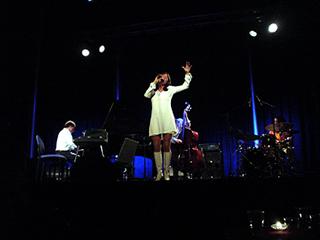
Rigmor Gustafsson and Jacky Terrasson Trio in Concert, Cosmopolite Oslo, September 2005 (Both photos: Norwegianblogger)

Thursday, September 15, 2005
Crash - what a movie!
 Last week I saw the movie Crash with Sandra Bullock, Don Cheadle, Brendan Fraser, Matt Dillon, Ryan Phillippe and Jennifer Esposito. Wow, that movie was a ride! You never knew what was going to happen or who’s the good or bad guy, in one moment a hero, in the next a criminal. Sometimes it felt really uncomfortable, because it plays with a lot of our emotions and presuppositions. Scary! It also made me think about how often we view each other as characters more than real people. The images we make of our family and friends are stuck in our minds and are hard to get rid of. If you look one way, you’re supposed to act that way. If you’ve done that, you are like that! There is of course some truth in this, but at the same time: We are incredibly complex and consist of layers and layers inside; of emotions, of thoughts and of diverse roles and expectations. With one person we behave in one way, with another we act differently. I’ve often experienced that some think of me as a quiet and an almost shy person, while others think of me as a crazy, talking machine :). What’s the truth? Perhaps both, depending on the situation or the person I’m with? Maybe we’re supposed to live in that tension, not knowing 100 % who we are or how we are perceived? All in all: the movie shows us real people in real situations, and it shows people, all of them – that are in need of grace – from each other and from loving arms at the end of the road. I guess that's where we all need to be, knowing that each individual's life is a mix of being heroes and villains in the confusing state of living.
Last week I saw the movie Crash with Sandra Bullock, Don Cheadle, Brendan Fraser, Matt Dillon, Ryan Phillippe and Jennifer Esposito. Wow, that movie was a ride! You never knew what was going to happen or who’s the good or bad guy, in one moment a hero, in the next a criminal. Sometimes it felt really uncomfortable, because it plays with a lot of our emotions and presuppositions. Scary! It also made me think about how often we view each other as characters more than real people. The images we make of our family and friends are stuck in our minds and are hard to get rid of. If you look one way, you’re supposed to act that way. If you’ve done that, you are like that! There is of course some truth in this, but at the same time: We are incredibly complex and consist of layers and layers inside; of emotions, of thoughts and of diverse roles and expectations. With one person we behave in one way, with another we act differently. I’ve often experienced that some think of me as a quiet and an almost shy person, while others think of me as a crazy, talking machine :). What’s the truth? Perhaps both, depending on the situation or the person I’m with? Maybe we’re supposed to live in that tension, not knowing 100 % who we are or how we are perceived? All in all: the movie shows us real people in real situations, and it shows people, all of them – that are in need of grace – from each other and from loving arms at the end of the road. I guess that's where we all need to be, knowing that each individual's life is a mix of being heroes and villains in the confusing state of living.
Saturday, September 10, 2005
Justice for the World - UNDP
 Crown Prince Haakon of Norway and Prime Minister Kjell Magne Bondevik at the launch of the Human Development Report 2005 (Photo: Norwegianblogger)
Crown Prince Haakon of Norway and Prime Minister Kjell Magne Bondevik at the launch of the Human Development Report 2005 (Photo: Norwegianblogger)
Friday, September 02, 2005
Terracotta warriors
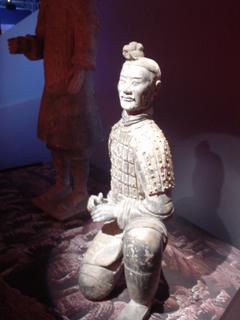 Yesterday I was looking into the eyes of warriors from 210 BC. A strange experience. At the historical museum here in Oslo there's an exhibition of several artefacts from China, among them are two terracotta warriors and several smaller figures. It's not the grandest of exhibits, but it's worth the entrance fee. I went with some of my colleagues, and we had a great time. The artefacts are placed in a setting of sounds, lights and visual effects. It's kind of interesting to see the contrast between the old artefacts and the super modern surroundings.
Yesterday I was looking into the eyes of warriors from 210 BC. A strange experience. At the historical museum here in Oslo there's an exhibition of several artefacts from China, among them are two terracotta warriors and several smaller figures. It's not the grandest of exhibits, but it's worth the entrance fee. I went with some of my colleagues, and we had a great time. The artefacts are placed in a setting of sounds, lights and visual effects. It's kind of interesting to see the contrast between the old artefacts and the super modern surroundings.

China Exhibition, Historisk Museum, Oslo (All photos: Norwegianblogger)
Tuesday, August 30, 2005
KG Hammar - faith & controversy
 I’ve been reading a book of / about the Archbishop of Church of Sweden, KG Hammar lately. While reading it, the Archbishop released a statement about planning to resign next summer. He’s been the Archbishop of the Church of Sweden for several years, and experienced the separation of the Church and State in Sweden as the head of the Church. He’s been a highly controversial leader in the church and has been under a lot of criticism. He’s raising questions, more than giving answers, he’s questioning a lot of the central doctrines of the church and has been an outspoken leader against war in Iraq, in favor of same-sex marriages and other current issues. It’s great to be able to listen to a person in more detail, than hearing a quotation or seeing an interpretation in the tabloids. A book is a wonderful tool in that respect. After spending some time “with him” in a book written as a conversation between him and Swedish author Ami Lönnroth I am intrigued. At the same time I understand why he is so controversial. He refuses to give clear answers and answers a lot of the questions for clarity with new questions. I don’t share his views on all matters, but in some ways, that doesn’t really matter. He don’t want me to agree with him – he wants me to find my way to God, and find faith without him giving me all the answers. I find in him an interesting approach to life and to faith that resonates with something within. His view of faith is connected to a strong emphasis on relationship, between God and us – and between human beings. Faith is first and foremost a relationship to God, and not a doctrine or a set of rules or regulations. This can be seen as a mystical approach to faith. Where there is unselfish love – you’ll find God. So – where does that leave us? I don’t know. His approach challenges me to the core – he urges me to ask questions myself – What is faith? What is spiritual leadership? Who is God? What is the human race? Where are we headed? Who am I? I guess the answer lies in opening up – opening up for questions, for answers, but most of all for the ability to live in openness towards God AND to other human beings. Not being afraid of all the questions, but slowly letting myself fall – out of control – out of the orderly systems – into the arms of God. Maybe not the answer the Archbishop would have preferred, but I believe it’s a process he would have supported. So thank you Archbishop KG Hammar for trusting us to find our own answers, and giving us tools and a framework from where to find our way. Maybe that is spiritual leadership? Exercising spiritual leadership, from a position of power, but in a spirit of servitude.
I’ve been reading a book of / about the Archbishop of Church of Sweden, KG Hammar lately. While reading it, the Archbishop released a statement about planning to resign next summer. He’s been the Archbishop of the Church of Sweden for several years, and experienced the separation of the Church and State in Sweden as the head of the Church. He’s been a highly controversial leader in the church and has been under a lot of criticism. He’s raising questions, more than giving answers, he’s questioning a lot of the central doctrines of the church and has been an outspoken leader against war in Iraq, in favor of same-sex marriages and other current issues. It’s great to be able to listen to a person in more detail, than hearing a quotation or seeing an interpretation in the tabloids. A book is a wonderful tool in that respect. After spending some time “with him” in a book written as a conversation between him and Swedish author Ami Lönnroth I am intrigued. At the same time I understand why he is so controversial. He refuses to give clear answers and answers a lot of the questions for clarity with new questions. I don’t share his views on all matters, but in some ways, that doesn’t really matter. He don’t want me to agree with him – he wants me to find my way to God, and find faith without him giving me all the answers. I find in him an interesting approach to life and to faith that resonates with something within. His view of faith is connected to a strong emphasis on relationship, between God and us – and between human beings. Faith is first and foremost a relationship to God, and not a doctrine or a set of rules or regulations. This can be seen as a mystical approach to faith. Where there is unselfish love – you’ll find God. So – where does that leave us? I don’t know. His approach challenges me to the core – he urges me to ask questions myself – What is faith? What is spiritual leadership? Who is God? What is the human race? Where are we headed? Who am I? I guess the answer lies in opening up – opening up for questions, for answers, but most of all for the ability to live in openness towards God AND to other human beings. Not being afraid of all the questions, but slowly letting myself fall – out of control – out of the orderly systems – into the arms of God. Maybe not the answer the Archbishop would have preferred, but I believe it’s a process he would have supported. So thank you Archbishop KG Hammar for trusting us to find our own answers, and giving us tools and a framework from where to find our way. Maybe that is spiritual leadership? Exercising spiritual leadership, from a position of power, but in a spirit of servitude.
Sunday, August 28, 2005
Lord of the Rings in Oslo
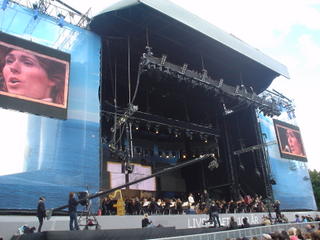 Lord of the Rings in Concert, Frognerparken, Oslo (All photos: Norwegianblogger)
Lord of the Rings in Concert, Frognerparken, Oslo (All photos: Norwegianblogger)
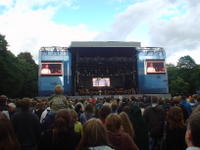
Saturday the biggest park in Oslo, Frognerparken, was filled with ten thousands of people for a Lord of the Rings Concert. Oslo Philharmonic Orchestra, Sissel Kyrkjebø, Anbjørg Lien, Sølvguttene, Oslo Bach Choir and others joined forces to give a two-hour performance of Howard Shore's score from the Lord of the Rings movies. I walked into the park a few minutes after they started to play, and walking underneath the big, old trees, with the sun shining and partying, picnicking people everywhere, felt like entering into an enormous party at Hobbiton. And then, to have the film music all over the place made the setting complete. The music was great, the orchestra was great, and the setting was fantastic. The concert could possibly have been cut down a little bit more - some parts felt a little repetitive, but in the great atmosphere Saturday, that didn't matter. During the last minutes of the concert, the sky opened and the rain poured down. That's Norway at this time of the year I guess - always difficult with open-air festivities. In spite of this: A great afternoon!
 In the evening A-ha played for 120 000 people, but I joined a friend to a play at the National Theater. It was called "Demokrati" ("Democracy") and is written by Michael Frayn. The play is about the German chancellor Willy Brandt, and his assistant Günter Guillaume, who after four years was revealed to be a spy for East Germany. An interesting plot for a play, and I was definitely impressed by it!
In the evening A-ha played for 120 000 people, but I joined a friend to a play at the National Theater. It was called "Demokrati" ("Democracy") and is written by Michael Frayn. The play is about the German chancellor Willy Brandt, and his assistant Günter Guillaume, who after four years was revealed to be a spy for East Germany. An interesting plot for a play, and I was definitely impressed by it!
Wednesday, August 24, 2005
A trip to the islands
 Flowers at Hovedøya Monastery, Oslo August 2005 (Photo: Norwegianblogger)
Flowers at Hovedøya Monastery, Oslo August 2005 (Photo: Norwegianblogger)
Yesterday I went on a trip to one of the islands in the Oslo fjord with my colleagues from work. I liked being able to spend time with my co-workers in such an environment. After a barbecue with hot-dogs and salad and a little hike on the island we had a tour of the old monastery at Hovedøya. It was incredibly interesting to listen to stories of how the monks managed to live there 800 years ago. Ruins of the monastery are still there, and it's a great spot.
Saturday, August 20, 2005
Oslo Jazz Festival
 Norwegian jazz-rock group Lava at the Rockefeller Music Hall, Oslo Jazz Festival August 2005 (Photo: Norwegianblogger)
Norwegian jazz-rock group Lava at the Rockefeller Music Hall, Oslo Jazz Festival August 2005 (Photo: Norwegianblogger)
Thursday, August 18, 2005
Murder of a spiritual giant
 The Church of Reconciliation in Taizé, France (Photo: Norwegianblogger 2002)
The Church of Reconciliation in Taizé, France (Photo: Norwegianblogger 2002)
Saturday, August 06, 2005
Kiss the frog!
 Kiss the frog, exhibition in the National Gallery, Oslo. (Photo: Norwegianblogger 2005)
Kiss the frog, exhibition in the National Gallery, Oslo. (Photo: Norwegianblogger 2005)I'm not talking about me, neither am I talking about fairy tales, but yesterday I went to see the much hyped exhibition "Kiss the frog" at the National Gallery here in Oslo. The exhibition was opened by Queen Sonja of Norway earlier this year, and will be in the museum until September 18th. Seeing the exhibition left me with a few questions about modern art and where the art world is headed. The main question is: What is the difference between art and design at one side and art and entertainment at the other side? First of all: Is it really important to discuss that at all? The theme of the exhibition is "the art of change", and to be art, I guess the artifacts should make us think and reflect. Was I challenged to reflect yesterday? Both yes and no, immediately after I left the building I felt a little empty and I asked myself: was this all? Was this really everything? Do I have to think of art as something that has to be discovered everywhere, or is it the setting it's placed in that makes it art? It's in the most prestigious museum in Norway, and that makes it art? I started to wonder, because parts of the exhibition could have been on a ride in Disneyland or as a part of the decoration in Vienna's Prater. Would I have reflected about the message and what the artist want to convey if I'd seen the same artifacts in Disneyland? Probably not, but is that a problem? Andy Warhol was known because he put the artifacts of everyday life in a museum, and suddenly it was art. In some ways I like that. The video installations was a part of the exhibition that in some ways left me puzzled. Yes, they were about the possibilities for change. One was about things that suddenly was alive, another one was about a dog flirting with a woman at a bridge, I guess both is about the possibilities for change, and we are challenged to think "what if....". At the same time we're living in an age were life is threatened by terrorists, threats to the environment, political upheavals, hunger in Africa and a lot of uncertainty. There are elements in the exhibition that points in these directions, but mostly I felt like I walked through a theme park. Again, I'm not opposed to theme parks, and I'm happy about change, also in the National Gallery. I heard a woman complaining to one of the guards yesterday that she was annoyed that everything had changed, and that the paintings not were in the exact spot they've always been. I don't share that view at all. If the art is going to challenge us and speak to us, I think it constantly should be put in new contexts. In one of the rooms at the exhibition, Erik Werenskiold's famous drawings from the Norwegian Folk tales was put opposite Vanessa Bairds enormous painting of weird situations involving children and adults. Did it work? Yes, in some ways I felt that Baird's painting made me think about the grotesque and challenging in the folk tales all over again, because, believe me, her painting is really challenging! All in all, the exhibition left me with a lot of questions about art and few answers. Perhaps we have the answer right there? If we are challenged to think and reflect, and are challenged to feel and react we are in the presence of art. Was I yesterday? Yes, I was challenged to think about art and were it is headed, but I'm not sure if I was challenged to reflect about the world, the future, the human race or my own life, in some ways I raise the question if the art world only loves itself. If we kiss that frog, what do we get? Maybe Narcissus?
Saturday, July 30, 2005
Am I weird?
Friday, July 29, 2005
Picking up memories
 Me and Grandpa, back in the mid 70s.
Me and Grandpa, back in the mid 70s. The photo with my father is interesting. This is typical for his sense of humor. I've obviously been sleeping, and has just woke up. My father is pointing at me with a smile on his face. My father had a lot of artistic gifts. One of them was being a fabulous storyteller. Several mornings I remember waking him up begging him to tell me stories. It wasn't stories from books, but he made them up right there, involving me and the rest of the family in incredible stories from far-a-way countries and kingdoms. Sometimes I was the hero of the story, and what a feeling that was! Sometimes he brought a sketch book and made incredible drawings and sketches. I loved it and I am in some ways puzzled by the fact that after being a commander in the army, he spent his whole life in a factory. It's actually a little sad. What would have happened if he'd been able to free these artistic gifts? I don't know, maybe he would have felt more fulfilled and would have been happier? Hard to say, but I'm sure glad I was able to hear the stories, see the drawings, and experience that art can make ties between fathers and sons, parents and children.
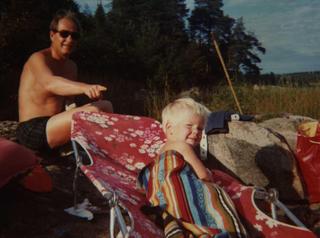 Dad & me
Dad & me
Wednesday, July 27, 2005
Queen Mary 2 in Oslo
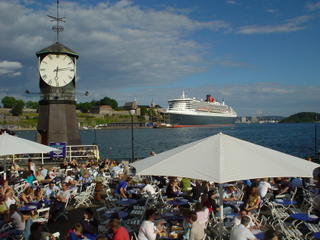
 Queen Mary 2 in Oslo, July 26, 2005 Both photos: Norwegianblogger
Queen Mary 2 in Oslo, July 26, 2005 Both photos: Norwegianblogger
Saturday, July 23, 2005
South Coast in summer
 Close to Portør, Norway Photo: Norwegianblogger 2005
Close to Portør, Norway Photo: Norwegianblogger 2005Another day we went to Jomfruland, an island with 70 inhabitants situated far out from the coast line. I enjoyed it tremendously. We went for hikes, for a swim in the ocean and spent hours in the sun.
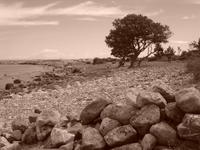 Jomfruland, Norway Photo: Norwegianblogger 2005
Jomfruland, Norway Photo: Norwegianblogger 2005In the evening we enjoyed a concert with the Norwegian poet and artist Odd Børretzen. The setting was perfect. The stage was set directly underneath two light houses, and with the humour and jazzy feeling of Lars Martin Myhre and Odd Børretzen's poetry and music, the evening was made perfect.

Lars Martin Myhre and Odd Børretzen in concert, Jomfruland, Norway. Photo: Norwegianblogger 2005

Coastal charm in Kragerø, Norway. Photo: Norwegianblogger 2005
Tuesday, July 12, 2005
Sad news from London
Sunday, July 03, 2005
Live 8 Live
Sunday, June 26, 2005
Gandalv in Oslo
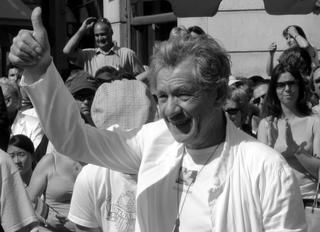
Sir Ian McKellen in Oslo, Norway, June 25, 2005 Photo: Norwegianblogger

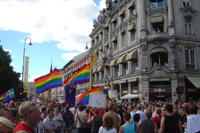
Europride parade (Photo: Norwegianblogger)
Thursday, June 16, 2005
Norway - a young nation
Wednesday, June 08, 2005
Swingin' London
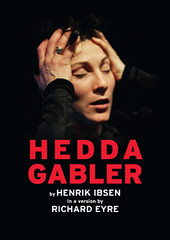 .
. 
.
In the evening I saw Val Kilmer and Charlotte Emmerson in The Postman always rings twice. Powerful, yet sensitive. Raw and violent, yet romantic - and both the main actors had a strong presence on stage.
Charlotte Emmerson and me in London.
Seeing both of these plays in one day knowing that the first was set in my native country, while the other one was set in the other country I've lived, made me think about the differences and similarities of these countries. I think the plays in many ways elaborated some typical traits of the people living in these countries, but at the same time are both stories universal. Seeing these two plays convinced me once more of the power of theater! I enjoyed it tremendously - and London - what a city. You just have to avoid some of the stressful parts of it, like Piccadilly Circus, Oxford street and the streets around Parliament. The rest of it can both be peaceful, interesting and diverse!
Tuesday, May 31, 2005
Where did summer go?
Thursday, May 19, 2005
Vienna, Maria João and a city of culture.

Vienna from the air, May 2005 (Photo: Norwegianblogger 2005)

This week I came back from Vienna after spending four days in this elegant city. It's obvious that this is a city where the rulers have been concerned about spending money on culture. There are magnificent buildings everywhere and at night they look even better with the lights. I'm impressed. I went with three friends and we had several cultural experiences. In my impression I have two highpoints: 1) the concert with jazz-artists Maria João and Mario Laginha at the Birdland jazz club in Vienna's Hilton hotel. Maria's voice and personality is extraordinary - there's not another word that covers it. In one minute she's like a bird, in the next a lion. She's like a thunderstorm and a Brazilian breeze, as Björk in one minute and as Ella Fitzgerald in the next. Not only in singing, but also in her expressions is she totally free at stage, loving every minute of it. Using her hands, dancing around stage, smiling, flirting and crying. She's so alive! Her musicians are the best and made the concert even better. After being sung into heaven we walked out of Birdland with a smile on our faces.

Maria João in Concert in Birdland Jazz Club, Vienna (Photo: Norwegianblogger May 2005)

For me the next evening's concert in Musikverein was the opposite of the experience in Birdland. Musikverein is probably the most beautiful concert hall in the world, made famous through the broadcasting of the New Years Concert each year. There's no better place to enjoy a concert, and the hall lived up to its reputation. When you walk into this hall your expectations rise. In some ways I felt a little sad when the orchestra entered the stage. They were dressed in Mozart costumes and played Mozart on routine, short pieces of music without any plan or artistic integrity. It was all accompanied by hundreds of digital cameras and mobile phones clicking and flashing throughout the whole concert (among them mine). In some ways I felt a little surprised that this wonderful concert hall was used to a concert like this. One of my friends said it well when he compared it to a Disneyland show (I love Disneyland by the way, but Disneyland is Disneyland - and Vienna is Vienna). For my sake I said that the board of the Musikverein is guilty of cultural prostitution when they use this wonderful hall to a concert like this, but I guess that's a bit too much. To be able to enter this wonderful hall is great, and listening to any kind of music enhances the experience. Imagine the Vienna Philharmonic Orchestra in this hall - that would have been something!
My second highpoint was definitely the Kunsthistoriches Museum - probably one of the best art museums in the world! The house in itself was a work of art - and the collection is impressive. We spent hours in the museum, and even had time for an hour in the museum's café. The cakes where like a work of art as well.
All in all: Vienna is highly recommendable!
Friday, May 13, 2005
Three days in Sápmi
are hundreds of miles of tundra and mountains. I was there for the National Sami Church Council and met a lot of the indiginous people of Norway. A great experience. Today I'm going with three friends to Vienna, Austria.

Finnmark at sunset, May 2005 (Photo: Norwegianblogger 2005)

 At first I thought this photo was blurred and I was going to erase it, but then... I realized: I like it! Photo: Norwegianblogger 2005
At first I thought this photo was blurred and I was going to erase it, but then... I realized: I like it! Photo: Norwegianblogger 2005
Wednesday, May 04, 2005
Nationalism and rights for the Sami people
Sunday, April 24, 2005
Being visible!
Saturday, April 23, 2005
Who are we really?

Spring in Oslo. (Photo: Norwegianblogger)

Tuesday, April 12, 2005
Dentist Paradise
Saturday, April 02, 2005
Death of a Pope
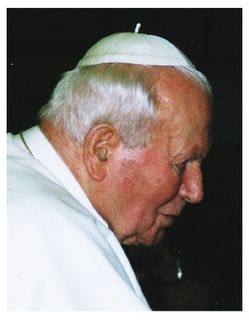
Pope John Paul II in Rome 2001. Photo: Norwegianblogger

Friday, April 01, 2005
A new star in Jazz?
Friday, March 25, 2005
Piaf, Morrison, Wilde and the others..
.jpg)
Père Lachaise, Paris - March 25, 2005. Photo: Norwegianblogger 2005

Yes, I've been visiting them all today - at their last resting place at Père Lachaise here in Paris. What a strange place. I arrived in the morning, and the sun shone through the trees and there was a little mist in the air. Even in sunlight it felt a little spooky. It's strange to meet death in such a profound way. At times I felt that I could smell it when I walked between the gravesites. All these people that were so filled with life, art and meant so much to so many now rest there, as bones and earth. Their work lives on though. The music of Chopin, the voice of Jim Morrison and Edith Piaf, the works of Moliere and Wilde and all the others that now are at the other side of life - dead in other words. Today I was thinking that most of the famous people resting in this graveyard experienced a lot of tragedy in their lives. Is that the price of fame? Is tragedy and sadness necessary for real art? It's hard to say, but today gave me an opportunity to think about the lives of these people and to observe (there we go again :) ) how different people react when they get to the gravesite of their heroes. At Jim Morrisson's grave there were a lot of young people with their headsets on - obviously listening to his music. At the same time there were guards at this place keeping an eye on everybody that came close and shouting out if something inappropriate was going on. The city of Paris had even closed off the area around the gravesite because of the doings of his fans. That's rock'n'roll I guess. At Chopin's grave it was really quiet, and a lot of flowers had been arranged around the white marble sculpture. At Oscar Wilde's gravesite I was amazed to see the ornamentation of the grave - when I got a little closer I could see that there were lots of marks from kisses that made up what I thought was the ornamentation. I think he would have liked that! At the same time I heard a guide say that someone had damaged parts of the sculpture because they hated that he was gay. I guess he wouldn't have been surprised about that either. At Edith Piaf's grave people stopped up and stood quietly around her grave looking sad. I guess she gave voice to a lot of people here in France during her lifetime. All in all - a visit to a cemetery could be an interesting experience. It surely was for me.
Today is a wonderful day in Paris by the way - it's summer and enjoy every minute of it. Tomorrow I'm going back to Norway so now I want to go out and enjoy the rest of the day. Au revoir!!
Thursday, March 24, 2005
Ani Di Franco and me in Paris
Tuesday, March 22, 2005
Invisible in Paris?
.jpg)
Notre Dame De Paris March 22, 2005. Photo: Norwegianblogger

Have I connected with God in Paris? I don't know - I feel that the churches are havens of peace in a noisy city, and I have felt called to pray and to meditate while I'm there. The Church of St. Severin in the Quartier Latin was especially a peacefull place today. There was a simple cross made of branches hanging above the altar - it was simple, but powerfull. I was praying, and then my thoughts started to wander - there's so much noise inside of me, but I'm trying to open up. In my mind I'm reaching out to the people I pass by or observe, but there's no response. Is God like that as well in my life? Is He reaching out to me, and I walk by - thinking of Him as an invisible presence that really don't know me? I dare to think that even here, in Paris, I am seen be Him, known by Him and loved by Him - and I hope that this knowledge will be felt as well - I guess this is my prayer for everyone I pass by, and for myself a late night in Paris. That we all are seen by Him - and when we're not seen by anyone, we are loved by the Creator of all things.
I do know that there are few other cities in this world that can compare! Looking forward to explore the city, my inner being and God's ways in the next days - and if you're here in Paris maybe I'll see you. Enjoy life!
Saturday, February 19, 2005
Paris on my mind
It's great to have something to look forward to. Paris - here I come!
Saturday, February 05, 2005
Loves us out of isolation
During the last week I've had a couple of conversations that have made me think more about my faith and where I'm at in my Christian walk. I've realized that a lot of the theological conflicts today are grounded in the view and interpretation of the Bible. I read something yesterday that made me think about this. It said that Christians today are challenged to live in the tension between being naive and intellectual. We are allowed to think, but at the same time we are told that the highest faith level in the
Wednesday, January 26, 2005
Words - words - words....
Monday, January 24, 2005
Nothing to say?
Wednesday, January 05, 2005
Oslo - can it get any better?
Tuesday, January 04, 2005
Friends in faraway places
Monday, January 03, 2005
Insomnia?
It's the ordinary days that make up most of our lives and I believe we have to take care of these days and nights that we get. Being 35 I realize that I don't live forever. I've always known that, but now I feel it. Maybe I've already lived half of my life? Man, I'm glad to be alive. I sincerely hope that knowing my mortality makes me live my life to the fullest!
Sunday, January 02, 2005
Making room for rage
A friend of mine told me once that he thought that I should be less analytical and more active, but now I think: Perhaps blogging could be a kind of action? Being me is partly being analytical, and this is a forum for that. I don't know if there will be anyone reading this, but I'm here. I'm writing, and sharing, and analyzing and trying to find my way in this wonderful, but confusing world. I'm here and you're welcome to share in this frightening, hopeful and great journey called life.
The tsunami in Asia has really been on my mind in the last week. I stayed in a hotel at Patong Beach a few years ago, I walked the beaches of Phi Phi island and I stayed in a shabby hostel at Penang island in Malaysia. It's been surreal to watch these locations totally destroyed and chaotic. People died those places and paradise is suddenly hell, and there is no escape - I've been there - I've stood at the exact places where the photographers and the CNN reporters stand today. Why do some people live - and others die? If the earthquake had happened a few years ago I could have been among the dead ones. I don't know why some people die. I think about it a lot, but I don't find a lot of answers. The Bishop of Oslo said something wise today. He said that in situations like now we should make room for anger. Being angry at God and letting ourselves ask questions. I guess this is my prayer this night: Help us to make room for rage when there are no answers to all the why's of our lives.
